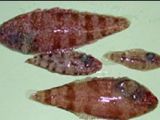Can you imagine a science fiction fish living at boiling temperatures in a sulfuric acid environment?
If you do not, you must know that scientists from University of Victoria, Canada, have found a new species of tonguefish (Symphurus) that lives in these conditions.
The fish were recorded on three expeditions to undersea volcanoes in the western Pacific. Huge numbers were seen to gather around the sulfur ponds which well up from beneath the seafloor. "There are a lot of toxic heavy metals coming out of these active volcanoes," explained Dr John Dower, a fisheries oceanographer. "The water is very warm, and it can be very acidic, the pH can be as low as two like sulphuric acid," he said. "And yet here we've got a group that has not previously been seen in this type of environment and they're doing very well - they're actually thriving."
The volcanic seamounts are found in the Mariana Arc, a 1,200km chain of volcanic islands between Guam and Japan. A number of hydrothermal vents were found, which draw water through cracks in the seafloor, heated to temperatures which can be well above 100C, loaded with dissolved metals and other chemicals.
In this type of habitat, oceanographers have previously found a range of specialized animals such as crabs, shrimp, mussels, and worms, but never fish; the tonguefish of the Mariana Arc seamounts is the first. "The density of these things is remarkable; we've determined that the abundances are actually about two orders of magnitude (100x) higher than what one typically finds on the continental shelf," said Dower. "So, these may be the highest flatfish densities seen anywhere, and it raises the puzzling question: what's supporting all that biomass?"
Probably the flatfish lives on resources in the sediments, like worms or even bacteria, but once they were seen to rip apart a dead fish that had fallen out of the water column above, so they may not be too choosy about where their meals come from.
The boiling material from beneath the seafloor, which emerges at more than 180C (355F), is denser than the surrounding water and simply lies in ponds in the depressions through which it emerges. "These flatfish live right up against the edge of the pools, and in a couple of cases we saw them out on the surface of a pool," said Dower. "We have video of a fish sitting on the molten sulfur and then moving off after a couple of minutes, apparently unharmed. They seem to be able to tolerate an environment that no other flatfish, and very few fish in general, are found in."
"The temperatures which these fish are experiencing means they must have remarkable stress defense mechanisms to be able to survive in that environment", said Dr Alex Rogers, a senior research fellow at the Zoological Society of London (ZSL). "So physiologically it's remarkable; but as a visual spectacle, it's like something from another planet", said Dower.
Photo credit: NOAA

 14 DAY TRIAL //
14 DAY TRIAL // 
